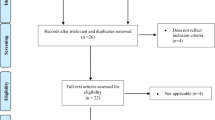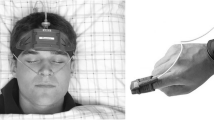Abstract
Measurement methods with graded complexity for use in the lab as well as for home sleep testing (HST) are available for the diagnosis of sleep apnea, and there are different classification systems in existence. Simplified HST measurements, which record fewer parameters than traditional four- to six-channel devices, can indicate sleep apnea and can be used as screening tool in high-prevalence patient groups. Peripheral arterial tonometry (PAT) is a technique which can be suitable for the diagnosis of sleep apnea in certain cases. Different measurement methods are used, which has an influence on the significance of the results. New minimal-contact and non-contact technologies of recording and analysis of surrogate parameters are under development. If they are validated by clinical studies, it will be possible to detect sleep apnea in need of treatment more effectively. In addition, this could become a solution to monitor the effectiveness of such treatment.
Access this chapter
Tax calculation will be finalised at checkout
Purchases are for personal use only
Similar content being viewed by others
Literature
Stuck, B. A., Arzt, M., Fietze, I., et al. (2020). Partial update of the German S3 guideline sleep-related breathing disorders in adults. Somnologie, 24, 176–208.
Chesson, A. L., Berry, R. B., & Pack, A. (2003). Practice parameters for the use of portable monitoring devices in the investigation of suspected obstructive sleep apnea in adults. Sleep, 26, 907–913.
Berry, R. B., Quan, S. F., Abreu, A. R., et al. (2020). The AASM manual for the scoring of sleep and associated events: Rules, terminology, and technical specification. Version 2.6. American Academy of Sleep Medicine.
Collop, N. A., Tracy, S. L., Kapur, V., et al. (2011). Obstructive sleep apnea devices for out-of-center (OOC) testing: Technology evaluation. Journal of Clinical Sleep Medicine, 7, 531–548.
Kapur, V. K., Auckley, D. H., Chowdhuri, S., et al. (2017). Clinical practice guideline for diagnostic testing for adult obstructive sleep apnea: An American Academy of Sleep Medicine Clinical Practice Guideline. Journal of Clinical Sleep Medicine, 13, 479–504.
Mayer, G., Arzt, M., Braumann, B., et al. (2017). German S3 guideline nonrestorative sleep/sleep disorders, chapter “Sleep-Related Breathing Disorders in Adults,” short version. Somnologie, 21, 290–301.
Escourrou, P., Grote, L., Penzel, T., et al. (2015). The diagnostic method has a strong influence on classification of obstructive sleep apnea. Journal of Sleep Research, 24, 730–738.
Berry, R. B., Budhiraja, R., Gottlieb, D. J., et al. (2012). Rules for scoring respiratory events in sleep: update of the 2007 AASM Manual for the Scoring of Sleep and Associated Events. Deliberations of the Sleep Apnea Definitions Task Force of the American Academy of Sleep Medicine. Journal of Clinical Sleep Medicine, 8, 597–619.
Caples, S. M., Rosen, C. L., Shen, W. K., et al. (2007). The scoring of cardiac events during sleep. Journal of Clinical Sleep Medicine, 3, 147–154.
Penzel, T., Kesper, K., Pinnow, I., et al. (2004). Peripheral arterial tonometry, oximetry and actigraphy for ambulatory recording of sleep apnea. Physiological Measurement, 25, 1025–1036.
Schöbel, C., Knorre, S., Glos, M., et al. (2018). Improved follow-up by peripheral arterial tonometry in CPAP-treated patients with obstructive sleep apnea and persistent excessive daytime sleepiness. Sleep & Breathing, 22, 1153–1160.
Yalamanchali, S., Farajian, V., Hamilton, C., et al. (2013). Diagnosis of obstructive sleep apnea by peripheral arterial tonometry: meta-analysis. JAMA Otolaryngology–Head and Neck Surgery, 139, 1343–1350.
Oldenburg, O., Arzt, M., Bitter, T., et al. (2015). Position paper “Sleep medicine in cardiology”. Der Kardiologe, 9, 140–158.
Penzel, T., Fietze, I., & Glos, M. (2020). Alternative algorithms and devices in sleep apnoea diagnosis: what we know and what we expect. Current Opinion in Pulmonary Medicine, 26, 650–656.
Dawson, A., Loving, R. T., Gordon, R. M., et al. (2015). Type III home sleep testing versus pulse oximetry: is the respiratory disturbance index better than the oxygen desaturation index to predict the apnoea-hypopnoea index measured during laboratory polysomnography? BMJ Open, 5, e007956.
Fietze, I., Dingli, K., Diefenbach, K., et al. (2004). Night-to-night variation of the oxygen desaturation index in sleep apnoea syndrome. The European Respiratory Journal, 24, 987–993.
Wang, N., Meng, Z., Ding, N., et al. (2020). Oxygen desaturation rate as a novel intermittent hypoxemia parameter in severe obstructive sleep apnea is strongly associated with hypertension. Journal of Clinical Sleep Medicine, 16, 1055–1062.
Zhang, S., Meng, Z., Zhang, X., et al. (2020). The rate of decrease in oxygen desaturation during severe obstructive sleep apnea syndrome is correlated with subjective excessive daytime sleepiness. Sleep & Breathing.
Sommermeyer, D., Zou, D., Ficker, J. H., et al. (2016). Detection of cardiovascular risk from a photoplethysmographic signal using a matching pursuit algorithm. Medical & Biological Engineering & Computing, 54, 1111–1121.
Pielmus, A. G., Mühlstef, J., Bresch, E., et al. (2021). Surrogate based continuous noninvasive blood pressure measurement. Biomedizinische Technik. Biomedical Engineering, 66, 231–245.
Gehring, J., Gesche, H., Drewniok, G., et al. (2018). Nocturnal blood pressure fluctuations measured by using pulse transit time in patients with severe obstructive sleep apnea syndrome. Sleep & Breathing, 22, 337–343.
Crowley, K. E., Rajaratnam, S. M., Shea, S. A., et al. (2013). Evaluation of a single-channel nasal pressure device to assess obstructive sleep apnea risk in laboratory and home environments. Journal of Clinical Sleep Medicine, 9, 109–116.
Keshavarzi, F., Mehdizadeh, S., Khazaie, H., et al. (2018). Objective assessment of obstructive sleep apnea in normal pregnant and preeclamptic women. Hypertension in Pregnancy, 37, 154–159.
Penzel, T., Kantelhardt, J. W., Bartsch, R. P., et al. (2016). Modulations of heart rate, ECG, and cardio-respiratory coupling observed in polysomnography. Frontiers in Physiology, 7, 460.
De Chazal, P., Heneghan, C., & Mcnicholas, W. T. (2009). Multimodal detection of sleep apnoea using electrocardiogram and oximetry signals. Philosophical Transactions. Series A, Mathematical, Physical, and Engineering Sciences, 367, 369–389.
Fontana, P., Martins, N. R. A., Camenzind, M., et al. (2019). Applicability of a textile ECG-belt for unattended sleep apnoea monitoring in a home setting. Sensors (Basel), 19, 3367.
Mueller, A., Fietze, I., Voelker, R., et al. (2006). Screening for sleep-related breathing disorders by transthoracic impedance recording integrated into a Holter ECG system. Journal of Sleep Research, 15, 455–462.
Chen, R., Chen, K., Dai, Y., et al. (2019). Utility of transthoracic impedance and novel algorithm for sleep apnea screening in pacemaker patient. Sleep & Breathing, 23, 741–746.
Defaye, P., Mendelson, M., Tamisier, R., et al. (2019). Validation of an apnea and hypopnea detection algorithm implemented in implantable cardioverter defibrillators. The AIRLESS study. Scientific Reports, 9, 9597.
Dias, M., Gonçalves, I., Amann, B., et al. (2017). Utility of new-generation pacemakers in sleep apnea screening. Sleep Medicine, 37, 27–31.
Glos, M., Sabil, A., Jelavic, K. S., et al. (2019). Tracheal sound analysis for detection of sleep disordered breathing. Somnologie, 23, 80–85.
Sabil, A., Schobel, C., Glos, M., et al. (2019). Apnea and hypopnea characterization using esophageal pressure, respiratory inductance plethysmography, and suprasternal pressure: a comparative study. Sleep & Breathing, 23, 1169–1176.
Narayan, S., Shivdare, P., Niranjan, T., et al. (2019). Noncontact identification of sleep-disturbed breathing from smartphone-recorded sounds validated by polysomnography. Sleep & Breathing, 23, 269–279.
Tiron, R., Lyon, G., Kilroy, H., et al. (2020). Screening for obstructive sleep apnea with novel hybrid acoustic smartphone app technology. Journal of Thoracic Disease, 12, 4476–4495.
Tenhunen, M., Elomaa, E., Sistonen, H., et al. (2013). Emfit movement sensor in evaluating nocturnal breathing. Respiratory Physiology & Neurobiology, 187, 183–189.
Perez-Macias, J. M., Tenhunen, M., Varri, A., et al. (2018). Detection of snores using source separation on an emfit signal. IEEE Journal of Biomedical and Health Informatics, 22, 1157–1167.
Paalasmaa, J., Toivonen, H., & Partinen, M. (2015). Adaptive heartbeat modeling for beat-to-beat heart rate measurement in ballistocardiograms. IEEE Journal of Biomedical and Health Informatics, 19, 1945–1952.
Fino, E., & Mazzetti, M. (2019). Monitoring healthy and disturbed sleep through smartphone applications: a review of experimental evidence. Sleep & Breathing, 23, 13–24.
Weinreich, G., Terjung, S., Wang, Y., et al. (2014). Validierung von SleepMinder® als Screeninggerät für die obstruktive Schlafapnoe. Somnologie, 18, 238–242.
Coronel, C., Wiesmeyr, C., Garn, H., et al. (2019). Measurement of respiratory effort in sleep by 3D camera and respiratory inductance plethysmography. Somnologie, 23, 86–92.
Veauthier, C., Ryczewski, J., Mansow-Model, S., et al. (2019). Contactless recording of sleep apnea and periodic leg movements by nocturnal 3-D-video and subsequent visual perceptive computing. Scientific Reports, 9, 16812.
Crinion, S. J., Tiron, R., Lyon, G., et al. (2020). Ambulatory detection of sleep apnea using a non-contact biomotion sensor. Journal of Sleep Research, 29, e12889.
Savage, H. O., Khushaba, R. N., Zaffaroni, A., et al. (2016). Development and validation of a novel non-contact monitor of nocturnal respiration for identifying sleep-disordered breathing in patients with heart failure. ESC Heart Fail, 3, 212–219.
Glos, M. T. D., & Schöbel, C. (2021). Sleep apnea screening using simplified systems. Somnologie, 25, 155–165.
Author information
Authors and Affiliations
Corresponding author
Editor information
Editors and Affiliations
Rights and permissions
Copyright information
© 2022 The Author(s), under exclusive license to Springer Nature Switzerland AG
About this chapter
Cite this chapter
Glos, M., Triché, D. (2022). Home Sleep Testing of Sleep Apnea. In: Penzel, T., Hornero, R. (eds) Advances in the Diagnosis and Treatment of Sleep Apnea . Advances in Experimental Medicine and Biology, vol 1384. Springer, Cham. https://doi.org/10.1007/978-3-031-06413-5_9
Download citation
DOI: https://doi.org/10.1007/978-3-031-06413-5_9
Published:
Publisher Name: Springer, Cham
Print ISBN: 978-3-031-06412-8
Online ISBN: 978-3-031-06413-5
eBook Packages: Biomedical and Life SciencesBiomedical and Life Sciences (R0)




